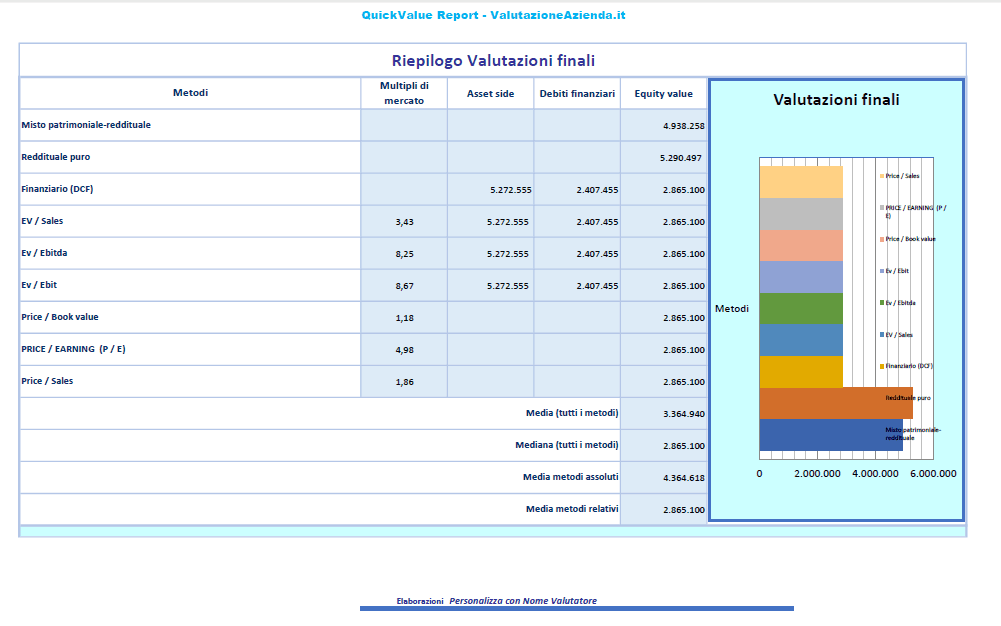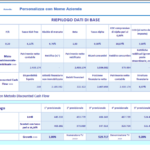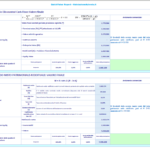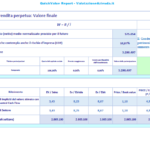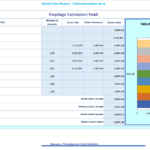
PROGRAMMA SEMPLIFICATO DI VALUTAZIONE AZIENDALE
Il programma guida l’utente nella stima dell’azienda con tre diversi metodi di valutazione, un metodo finanziario, quello più utilizzato nella prassi aziendalistica, costituito dal Discounted Cash Flow (DCF), da un metodo reddituale-patrimoniale, molto utilizzato nell’ambito delle valutazioni eseguite in ambito giudiziale, e da un metodo reddituale, quello reddituale puro, con rendita perpetua, che dà un’immediata visione del multiplo implicito applicato.
Il metodo di valutazione del Discounted Cash Flow (DCF), versione Asset side, è il più accreditato dalle moderne teorie aziendali, particolarmente idoneo nella stima del valore di mercato dell’impresa.
Il metodo del Discounted Cash Flow mette in relazione il valore aziendale ai flussi finanziari che potrà generare in futuro, scontati ad un tasso che tenga conto del rischio di impresa.
Il metodo misto patrimoniale-reddituale consente di tener conto in sede di valutazione sia degli aspetti reddituali che della componente patrimoniale dell’impresa.
Il metodo reddituale si basa esclusivamente sulla redditività prospettica dell’impresa.
Il programma si articola in tre fasi assistite di inserimento dei dati (all’interno delle caselle di colore bianco) alla base della valutazione.
Dopo aver inserito, in forma aggregata, i dati dell’ultimo bilancio consuntivo dell’impresa formante oggetto di valutazione, al secondo step vengono fornite apposite griglie ove inserire i dati necessari alla determinazione del tasso di interesse da utilizzare per l’attualizzazione e la capitalizzazione dei flussi finanziari e reddituali; in tale seconda fase sono già riportati in default tutti i dati indispensabili all’esecuzione dei calcoli, con indicazioni operative sulla tipologia di informazione da fornire ove risulti necessario modificarli.
Nel terzo step viene proposta una scheda per la determinazione dei flussi finanziari prospettici dell’impresa da valutare, ove sono già riportati in default tutti i dati indispensabili, tratti dai dati di bilancio inseriti nel primo step. Ove risulti necessario modificare le assunzioni ivi riportate in automatico, o semplicemente per eseguire delle simulazioni diverse, vengono fornite indicazioni operative in merito al tipo di informazione da inserire in ciascun campo.
L’ultima scheda del programma riporta un breve report delle valutazioni eseguite con i predetti tre metodi, con riepilogo delle assunzioni alla loro base. In tale ultima scheda è anche possibile inserire i multipli del settore per comparare le valutazioni eseguite con i tre metodi indiretti (basati su formule) con quelli diretti di mercato.
Quick VALUE
QUICK assisted business valuation PROGRAM
The program guides the user in estimating the company with three different valuation methods, a financial method, the one most used in business practice, consisting of the Discounted Cash Flow (DCF), an income-equity method, widely used in of the valuations carried out in the judicial field, and by an income method, the pure income method, with perpetuity, which gives an immediate view of the implicit multiple applied.
The Discounted Cash Flow (DCF) valuation method, Asset side version, is the most accredited by modern business theories, particularly suitable for estimating the market value of the company.
The Discounted Cash Flow method relates the company value to the cash flows it could generate in the future, discounted at a rate that takes into account the business risk.
The mixed equity-income method makes it possible to take into account both the income aspects and the equity component of the company during the evaluation.
The income method is based exclusively on the prospective profitability of the company.
The program is divided into three assisted phases of data entry (within the white boxes) at the basis of the evaluation.
After having entered, in aggregate form, the data of the last final balance sheet of the company being valued, in the second step specific grids are provided in which to enter the data necessary to determine the interest rate to be used for discounting and capitalization financial and income flows; in this second phase all the data indispensable for the execution of the calculations are already set to default, with operational indications on the type of information to be provided where it is necessary to modify them.
In the third step, a form is proposed for determining the prospective financial flows of the company to be valued, where all the indispensable data, taken from the balance sheet data entered in the first step, are already reported in default. Where it is necessary to

